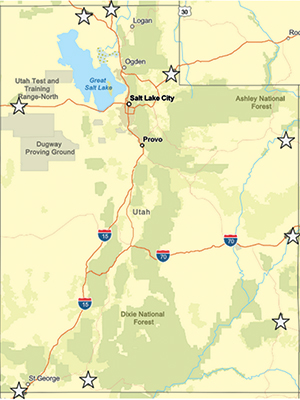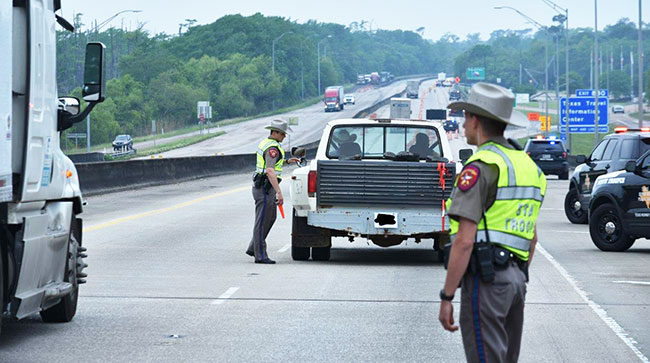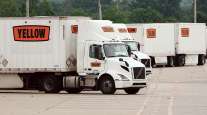Staff Reporter
Truckers Exempt From Utah Traveler Declaration Form

[Ensure you have all the info you need in these unprecedented times. Subscribe now.]
Truck drivers and other travelers representing certain industries have been exempted from Utah Gov. Gary Herbert’s recent executive order requiring people entering the state to complete a travel declaration form.
Similar screening measures by Rhode Island, Florida and Texas were put in place, and commercial trucks are exempt in each case.
Under the Utah order, issued April 9 in response to the coronavirus pandemic, a targeted wireless emergency alert will be deployed on certain highways that cross state borders into Utah. When a person crosses into Utah, he or she will receive a text message containing a link to the declaration form.
The order, which took effect April 10, will remain in effect through May 1.

Herbert
The Utah Department of Transportation worked with other state agencies to flag certain entry points along key routes, such as interstates 15, 70, 80 and 84, as well as U.S. routes 40, 89 and 491/191. Utah touches Nevada, Arizona, Colorado, Idaho, New Mexico and Wyoming.
According to the governor’s notice, the Utah Department of Technology Services will ensure the encryption of all data collected and transmitted.
Utah government officials have clarified that commercial truck drivers, airline employees and travelers acting in their official capacity as law enforcement officers, firefighters, paramedics, emergency medical technicians, members of the U.S. Armed Forces and healthcare providers have been exempted from the executive order. They will still receive a notification on their phones, but they can ignore it.

Map showing areas where inbound Utah travelers will be asked to fill out declaration forms. (Utah DOT)
Rick Clasby, executive director of the Utah Trucking Association, said his group and other trucking industry representatives were quick to express their concerns about the order with state officials.
“They made the right decision to exempt trucks and clarify any possible impediment. We’re happy about that,” Clasby said. “We’re grateful for the government leadership for listening and hearing concerns.”
The travel declaration form asks travelers for such information as entry point into the state, name, date of birth, whether they have tested positive for COVID-19 or are exhibiting symptoms, contact information and places they have traveled within the previous two weeks. If travelers state on their declarations that they are exhibiting symptoms, they will be contacted by Utah’s tracing team and quarantined.
Other than those exempted from the executive order, all travelers age 18 and older who enter Utah, either by roads or through Salt Lake City International Airport, must complete the form within three hours of crossing into the state. The alert system should coordinate with phones to ensure people receive the text at least once. However, phones may receive the alert multiple times in some cases.
“I am impressed with the extraordinary things that Utahns are doing each day to help one another stay safe and stay home,” Herbert said. “In recent days, however, we have seen an uptick in travel on our roads. We need to limit our travel to essential purposes only. Our goal is to trace potential cases of COVID-19 in inbound travelers.”
According to the Utah Department of Health, there have been 2,303 cases of COVID-19 in the state as of April 12.
The program can’t separate inbound and outbound traffic, meaning motorists who are leaving the state also will receive the wireless alert. Those drivers can ignore it until they return to Utah.
In Rhode Island, Gov. Gina Raimondo issued an executive order March 28 requiring any person coming into her state for a non-work-related purpose to immediately self-quarantine for 14 days. This executive order repealed a previous order that specifically targeted travelers from New York, the state hit hardest by the virus.
Florida Gov. Ron DeSantis signed an executive order March 27 establishing checkpoints along roadways where law enforcement officials can collect information from incoming travelers. Specifically, people are asked to provide information on the origin of their travel and the address of where they’ll be spending the 14-day quarantine period.
Florida Trucking Association President Ken Armstrong said the checkpoints, which are located on I-10 and I-95, are meant to identify people from serious hot spots such as Louisiana and New York City.

Checkpoints in Texas. (Texas Department of Public Safety)
In Texas, Gov. Greg Abbott tasked the Department of Public Safety with increasing its presence along the state’s border with Louisiana. Troopers have established screening stations on major roadways to gather required travel forms from people crossing the border.
Want more news? Listen to today's daily briefing:




